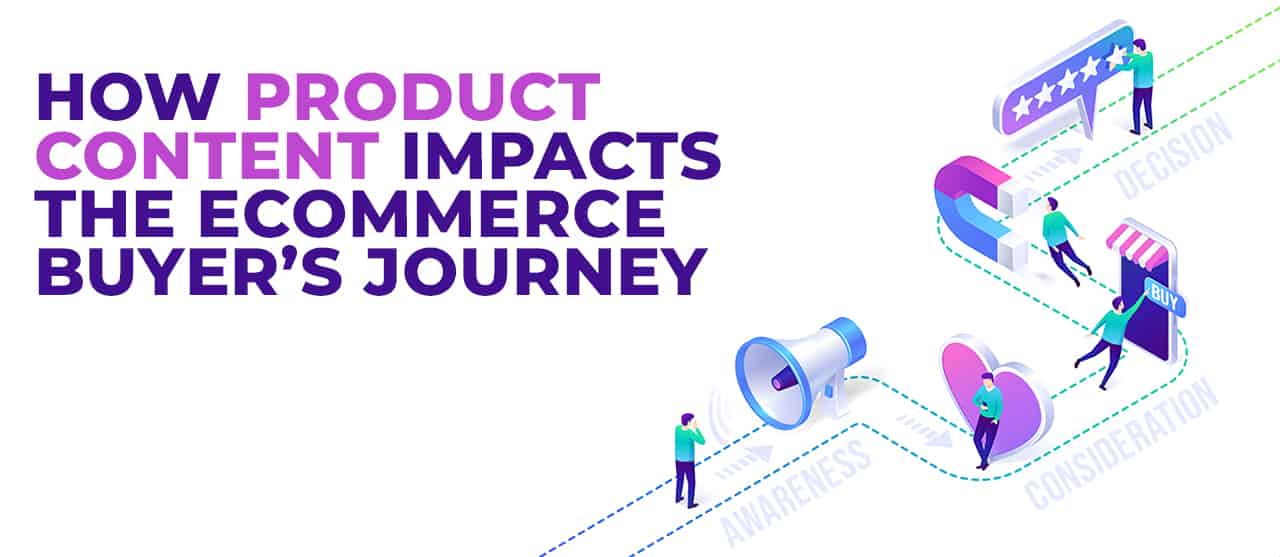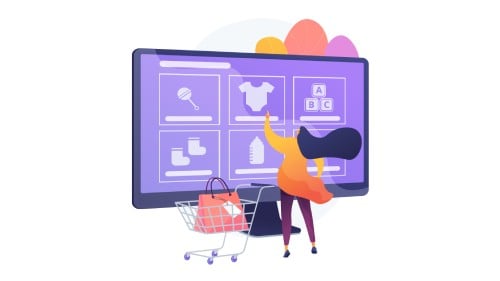
“Life is a journey, not a destination” – Ralph Waldo Emerson
This famous quote is so applicable to eCommerce shoppers. Call it an eCommerce customer journey or an online buyer’s journey, today’s online retailers need to be aware of their shoppers’ needs and where they are at in their purchase decision-making process. Yes, there are “impulsive” purchases, however, most online shoppers go through a multi-step decision-making process, especially when buying expensive or complex products.
To increase their online sales and boost customer engagement, online retailers should focus on the customer’s entire journey and factors they can control to provide a positive customer experience (CX). According to this Forbes article, 86% of buyers will pay more for an improved CX, so not only can you improve your odds of winning, you can do so at a higher price and improve your revenue and profit.
So, how can eCommerce retailers leverage product content to improve the customer journey at every stage?
The Stages of the eCommerce Customer Journey
The term “customer journey” is defined as the overall experience that any individual customer has with a particular brand. This experience starts when the consumer learns about the brand and continues until they make a purchase.
Why is the customer journey critical for brands selling their products online? Online shoppers build their brand perception based on the outcome of their customer journeys. Today’s online shoppers don’t simply buy a product, they buy an entire brand experience that is made up of factors like brand interaction, relevant product information, ease of purchase, and customer service.
While any customer journey can have multiple stages for different online retailers, we’ll explore three essential stages that all online shoppers go through:
1. Awareness
In this stage of the customer journey, shoppers learn about your brand and product portfolio. This stage is usually preceded by the “problem” or “opportunity” stage where consumers start to research potential products.
At this stage, eCommerce retailers need to create awareness about their products or services, and how they address consumers’ problems or opportunities. After consumers are aware of retailers’ products or services, those “aware” consumers can then be converted into leads in the sales funnel.
2. Consideration
At this stage, consumers move beyond basic browsing (i.e., via search engines) to show real interest in a particular retail brand. For example, shoppers may browse a specific product or service page to start gathering more information. Additionally, they may start doing external research about the brand or products through online product ratings and reviews or competitors’ brand or product pages.
Some consumers may even add their target products to their wish lists or shopping carts for later consideration. At this stage, eCommerce retailers should encourage more customer interaction and focus on reducing bounce rates. Essentially, this stage allows retailers to analyze what consumers are looking for and whether or not they are satisfied with what they are finding.
3. Decision
This is the final stage of the customer journey, where they choose to make the purchase or not. At this stage, retailers should eliminate or minimize any friction that could result in the customer abandoning the shopping cart or opting for a competitive brand.
At this stage, retailers must honor all of their customer promises like free shipping or discounts or risk disengaging them from the purchase process.
How Product Content Impacts Each Customer Journey Stage
Product content or information is critical to keep customers moving forward in their journey to the next stage. Accurate product content can be delivered in multiple forms including product descriptions, product buying guides, specifications, product images and videos, and support-related information.
Read: How accurate product content can be used to improve your consumer’s shopping experience
Below we discuss how eCommerce retailers can leverage their product content to improve each of the customer journey stages:
Product Content for the Awareness Stage
In the awareness stage, retailers should use product content to create more brand and product awareness among their target customer bases. For example:
- Building the product content based on target consumer personas and their needs.
- Creating product content that can be easily shared via various digital channels like short and easy-to-understand images or videos that quickly illustrate how a product can solve their problem or provide the desired benefit. For example, “headphones that are comfortable to wear all day” or “children’s toys with cost-effective rechargeable batteries.” Focus on words like performance, durability, and convenience that communicate benefits.
- Ensuring product content in this stage is sufficiently informative and educational, without overloading consumers with too many details.
Product Content for the Consideration Stage
- In the consideration stage, retailers should create product content that highlights why consumers should choose to buy from them.
- For the relevant product pages, highlight why they should buy this product on this website (for example, free shipping or extended warranty), especially in ways that differentiate the brand from competitors.
- Product content should be designed based on the typical customer journey for the product. For example, “which sources are driving the incoming traffic?” or “which web pages are they landing on?” or “how are they navigating to or searching for their desired product?” Develop product content that can be easily used at each of these likely customer touchpoints.
- Make use of product comparison guides that highlight why your product features are more important when selecting a product. At the same time, highlight the potential risk of selecting products that do not deliver the most important benefits.
Product Content for the Decision Stage (and Beyond)
In the decision stage, retailers must use product content to emphasize their value proposition during the check-out process. This approach can include:
- FAQ content to help resolve any customer objections and seal the deal.
- When appropriate, providing “free product trials” or “product demos” can help them more quickly and confidently decide to purchase your product.
- Immediately post-decision, offer a quick survey asking what worked (or did not work) in their purchasing process, and encourage customer feedback. It’s important at this stage to demonstrate that you care.
- Establishing ways for your customers to stay engaged after the sale through social media platforms, newsletter subscriptions, and more. This encourages future repeat purchases and can help build brand loyalty.
Conclusion
For online retailers, product content is a fundamental building block for fostering positive customer relationships and creating engaging customer experiences. As discussed, product content can be customized for every stage of the customer journey to help them make more confident purchase decisions.
With extensive experience delivering eCommerce product content services, EnFuse solutions have enabled global eCommerce retailers to transform and scale their businesses and grow their revenue and profit. Interested in learning more about our eCommerce solutions? Feel free to contact us today.
Leave a Reply
Your email address will not be published. Required fields are marked *


















Comment